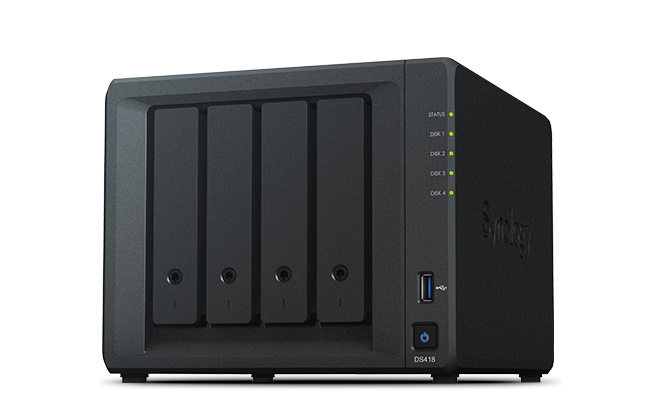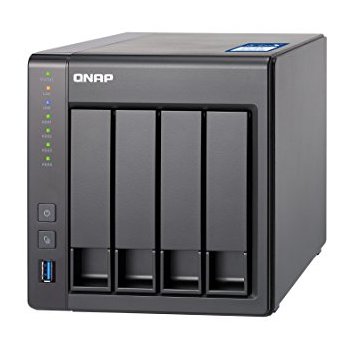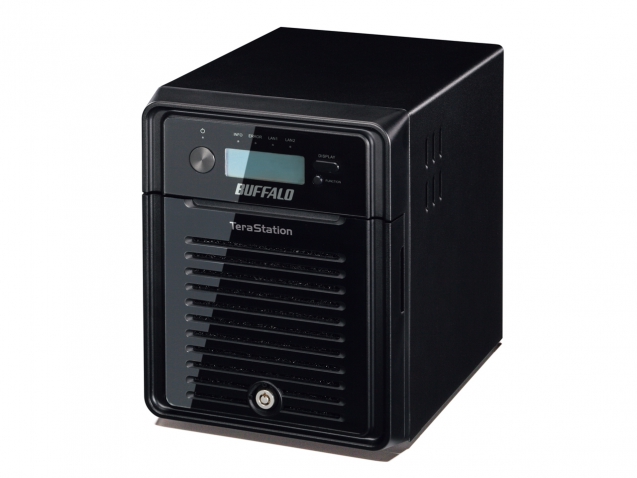*The data in this table may update every week because the changes for each device’s features and prices are tracked regularly. Last Update was on December 21, 2017.

|

|

|

|

|
|
|
Realtek RTD1296 Quad-core 1.4 GHz
Realtek RTD1296 Quad-core 1.4 GHz |
ARM Cortex-A15 Quad Core 1.7GHz
ARM Cortex-A15 Quad Core 1.7GHz |
Intel Pentium N3710 1.6 GHz quad-core (Burst speed up to 2.56 GHz)
Intel Pentium N3710 1.6 GHz quad-core (Burst speed up to 2.56 GHz) |
|||
|
2GB DDR4
2GB DDR4 |
8GB RAM
8GB RAM |
4GB DDR3L
4GB DDR3L |
|||
|
48 TB (12 TB HDD x 4)
48 TB (12 TB HDD x 4) |
4 x 3.5″/2.5″ SATA 6Gb/s HDDs/SSDs
4 x 3.5″/2.5″ SATA 6Gb/s HDDs/SSDs |
4-Bay Up to 40 TB
4-Bay Up to 40 TB |
|||
|
Dual GbE LAN Ports (w/ Link Aggregation / Failover support), 2 x USB 3.0
Dual GbE LAN Ports (w/ Link Aggregation / Failover support), 2 x USB 3.0 |
3 x USB 3.0 port (Front x1 ; Rear x 2), 1 x 10 Gigabit SFP+ LAN Port, 2 x GbE RJ45
3 x USB 3.0 port (Front x1 ; Rear x 2), 1 x 10 Gigabit SFP+ LAN Port, 2 x GbE RJ45 |
Gigabit Ethernet x2
Gigabit Ethernet x2
|
|||
Synology Hybrid RAID, BASIC, JBOD, RAID 1 to RAID 6, RAID 10
|
RAID 0/1/5/6/10, + hot spare, single, JBOD
|
JBOD, Spanning, RAID 0, RAID 1, RAID 5, RAID 10
|
|||
 |
 |
 |
|||
|
~$460
~$460 |
~$599
~$599 |
~$499
$499 |
|||
    
|
    
|
    
|
|
Network-attached storage appliances are one of he most essential computer equipment employed by individuals and small and medium businesses. In essence they are powerful data servers that protect their allocated data by using cloning technology and powerful encryption. They are usually accessible via the internal network or directly through USB ports for example. Usually they are standalone devices that are designed in either tower or small cube cases while enterprise versions can be placed on racks.
It has become common to include various technology such as media servers and printer sharing as well. Nowadays NAS devices are configured through applications or web interfaces. A variety of protocols are made compatible such as NFS (used on UNIX systems), SMB (Microsoft Windows file sharing) and AFP (Apple Mac).
NAS devices are one of the most important requirements when dealing with sensitive data. Depending on the exact model they can provide a minimum of 2 bays where the hard drives (both traditional drives and SSD) can be placed. By using different levels of RAID technology the data can be cloned and ensure reliable storage of the information. All contemporary manufacturers include options that allow the owners to tweak the performance-redundancy ratio.
There are several important factors that every prospective buyer should consider when choosing their device:
- Hardware Components — Probably one of the most important characteristics of every device are the hardware components that power them up. All manufacturers release information on the used processor and memory combination so that the users can compare the performance of the machines.
- Capacity — NAS devices can be compared by their capacity. This refers to both the available drive bays (starting at the minimum 2), as well as the total supported capacity in TB.
- Connectivity Options — This refers to the available options that connect the NAS server to other computers or to an internal network. Ethernet and USB ports are standard across all price ranges while higher-end models can feature dual network links, Thunderbolt, USB Type-C and related newer technologies.
- Encryption Ciphers — Hardware encryption is one of the most important security features bundled into such appliances. A special module secures all stored data so that it cannot be decrypted if stolen by computer criminals. Professional-grade NAS devices utilize military-grade encryption that guarantees a very strong protection.
- Additional Features — Extras usually vary according to the vendor and model series. Examples include automated backups, cloud operations, log files creation, media servers and etc.
 |
|
The Synology DS418 NAS is among the best sellers in the SMB category. This particular model supports up to 4 drives and employs 2 GB DDR4 along with a powerful processor in order to provide top performance. Synology is a market leader in the segment and has designed several features that cater to business owners.
The company has developed a collaborative solution that allows several users to work on office documents (spreadsheets and rich text documents for example) storing the data securely on the NAS. Public and private cloud instances can be set easily in order to facilitate easier file sharing over the Internet. Home users can rely on a 4k Multimedia server with hardware transcoding which guarantees that even the highest quality of video will play without any issues.
The Synology DS418 NAS server includes the Synology Hybrid RAID (SHR) technology which automates the volume management. This makes it very easy to administrate the installed hard drives and protect the data from incidents. An easy mode is available for beginner users while adept users can take advantage of the wide range of capabilities.
The model is especially suited for integration into complex environments. Synology includes a surveillance station that allows web cameras to be recorded, monitored and managed. Backups for desktop, laptop and mobile devices can also be automated when an appropriate setup has been configured.

 Low price.
Low price. Hardware encrypton.
Hardware encrypton. Cloud creation capabilities.
Cloud creation capabilities. Surveillance station.
Surveillance station. Multimedia server.
Multimedia server.
 Lack of varied direct connectivity options such as Thunderbolt, USB Type-C and etc.
Lack of varied direct connectivity options such as Thunderbolt, USB Type-C and etc. Plastic case.
Plastic case.  |
|
The Qnap TS-431X2-8G NAS server from QNAP is a high-performance model that is specifically developed for the small and medium business owners. It is equipped with a special processor and expandable memory that guarantee top speeds (both read and write operations). Like the Synology unit it supports hardware encryption (military-grade AES-256) and still manages to deliver fast speeds. The model provides two built-in Gigabit Ethernet ports and a 10GbE SFP+ port connection for fast network transfer. This NAS supports SSD cache acceleration, a new feature that greatly boosts the IOPS performance.
On the software side the QNAP TS-431X2 supports block-based Snapshots that record and save files and metadata at any time. This means that if a drive fails or a dangerous malware infection happens the data can be safely retrieved from the snapshot. Multiple versions can be retrieved as this model supports up to 64 snapshots per volume. A replica feature allows for double protection by sending a copy to a remote QNAP NAS server for safekeeping.
The Container Station is something that distinguishes the QNAP product from other vendors. It integrates virtualization appliances that allows the system administrators to set up multiple isolated Linux systems. Other built-in software services include “Qfiling”, an automated file organization application and “Qsirch” which is a feature-rich search tool.
The built-in collaborative framework allows users to store, share and edit notes, emails and contacts. A modular operating system is employed that allows new modules to be easily added to the system. The stored data can be shared and synced using multiple protocols. It also supports flexible backup and disaster recovery solutions. Security options include antivirus software, IP blocking, two-factor authentication and others. The included surveillance station module is a professional-grade solution bundle with the device.

 High-performance and hardware encryption.
High-performance and hardware encryption.  Snapshots, Backups and Recovery Options.
Snapshots, Backups and Recovery Options.  Container and Surveillance station solutions included.
Container and Surveillance station solutions included. 
 Some apps have been reported to have performance issues.
Some apps have been reported to have performance issues.  Limited expansion.
Limited expansion. |
|
Western digital offer several NAS server iterations, for this particular article we have chosen the PR4100 model. The product is bundled with WD SmartWare Pro, an application that allows backups to be made using both Microsoft Windows and Mac OS X. The device itself features an integrated copy button that automatically starts to backup files instantly.
This NAS server allows the administrators to set up password protection for the RAID volumes, as well as configure 256-bit AES encryption. A useful feature is the availability of two power ports that guarantee a backup line in case of a power failure.
Computer users will find that the built-in transcoding server along with the Plex instance very useful when organizing their digital media collections. Other types of content can be syncronized with the specialist WD Sync function. The PR4100 NAS server is also compatible with the Adobe Creative Cloud which makes it a natural choice for creative teams.

 Versatile Backup Tools.
Versatile Backup Tools.  Third-party app support.
Third-party app support.  Large capacity.
Large capacity. 
 Owners report confusing installation procedures.
Owners report confusing installation procedures.  Lack of advanced server options.
Lack of advanced server options. |
|
The Drobo 5d3 NAS is a 5-bay device that has been created for media professionals and small and business owners. Alongside the typical network ports it also bundles Thunderbolt 3 connectivity options for faster delivery. The vendor has optimized the device to be fully-integrated into a 4K/5K media workflow.
Drobo integrated their award-winning BeyondRAID technology that protects the stored data against single or dual disk failure. The installed drives can be added, hot-swapped and updated in real time with zero downtime. The Drobo is compatible with the Time Machine software allowing advanced configuration of the backup generation.
An additional feature found in the Drobo 5D3 units is the accelerator bay that contains a mSATA card holder. Patented technology is used to keep a record of the most frequently accessed data that is delivered at faster speeds. The bay accepts standard mSATA SSD drives which leaves all five 3.5” drives bays available for high-capacity HDDs. Data protection is guaranteed even when a power outage. In the event of such an issue a battery backup is bundled into the drives to protect the data in memory or the cache. Immediately any in-flight data is moved to the onboard flash for protection.

 Proprietary RAID technology.
Proprietary RAID technology.  Enhanced Backup Capabilities.
Enhanced Backup Capabilities.  Accelerator Bay with Accelerator Cache technology.
Accelerator Bay with Accelerator Cache technology. 
 Confusing setup.
Confusing setup.  Users report compatibility issues with some drives.
Users report compatibility issues with some drives. |
|
This is a classic NAS server from Buffalo Technology that is widely regarded as one of the best options for small and small business owners. The TeraStation TS3400 series are a reliable choice for everyone that seeks wider connectivity options. The NAS server can be connected to any network and computer as it even has a serial port built-in. Customers can purchase a model in both desktop and rackmount versions.
Prospective buyers should note that this NAS server provides a rich list of RAID array options. All popular protocols are supported, the software also support network monitoring and simultaneous NAS and iSCSI target functionality. Software configuration is done over an accessible web interface. The backup options include a failover setup creation which can interact with other Buffalo NAS devices. A replication feature is also included which allows data to be synchronized over several devices. The Apple Time Machine backups can be configured to use the NAS, as well as the S3 Amazon cloud backup options. System administrators will appreciate the ability to backup files to USB storage or other equipment using the rsync protocol.
With each bundle 11 licenses are given out for a professional backup software. This means that with a single devices a SOHO network can operate with data assurance. The vendor has bundled support for Buffalo WebAccess, a web client protocol that allows the data to be accessed from mobile apps. A surveillance server is ready to be used with 5 cameras. Buffalo’s TeraStation 3400 is Citrix ready to integrate into any enterprise workflow.

 Surveillance server .
Surveillance server .  Wide range of connectivity options.
Wide range of connectivity options.  Compatability with services and cloud platforms.
Compatability with services and cloud platforms. 
 Aged hardware.
Aged hardware.  No SSD caching support.
No SSD caching support.
|
- Server Message Block (SMB) — A protocol used for sharing files, printers and serial ports across an internal network. This is the most popular technology employed by the Microsoft Windows operating system family for files and printers sharing.
- RAID — RAID stands for Redundant Array of Independent Disks, a data storage virtualization technology that combines multiple hard drives into a single logical volume. Depending on the chosen RAID level a different ratio of performance to redundancy is enforced.
- NFS — This is a distributed file system that is popularly used to share data over a network. It is standard across most UNIX-like operating systems such as Linux and Mac OS X.
- Replication — Replication in computing involves sharing information so as to ensure consistency between redundant resources, such as software or hardware components, to improve reliability, fault-tolerance, or accessibility.
- CIFS — This is a standard protocol for sharing files across corporate intranets and the Internet.
- Snapshots — A recorded stage of a system at a particular point in time.
- Logical Volume — This is a common type of volume management that provides storage virtualization. Using this scheme the users are not restricted to physical disk sizes. The maintained volume can be dynamically expanded and manipulated.
- Hot Swap — The ability to replace, add and remove drives without stopping the NAS server.
- Rsync — An utility for efficient transfer and synchronization of files across computer systems that relies on timestamps and size of the files.
- Transcoding — Automatic media file conversation used by media streaming servers.


